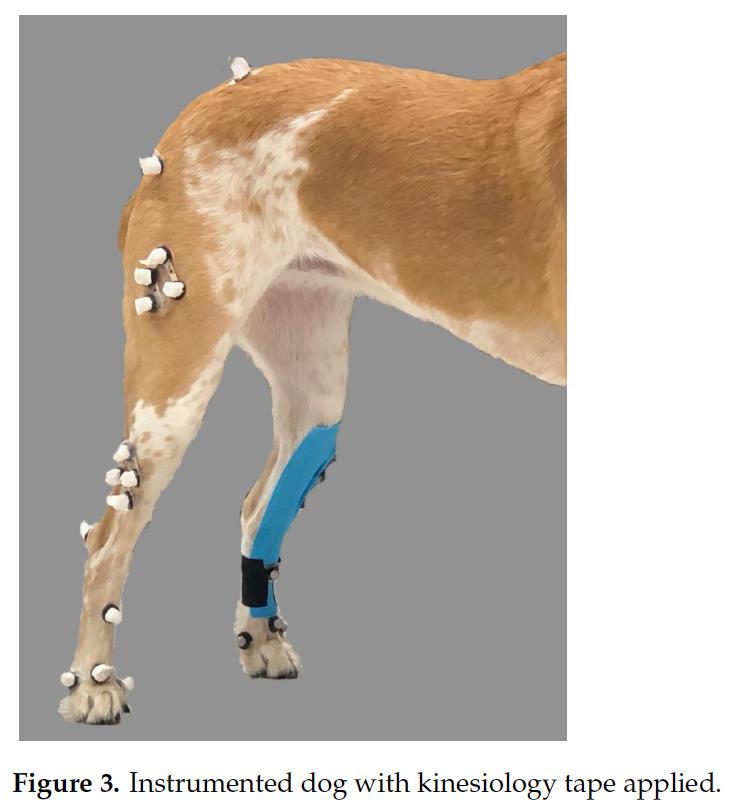Laurie's Blogs.
Sep 2025
Kinesiology Taping Does Not Affect Tarsal Joint Motion During Selected Exercises in Dogs

Thank you to Michael Yeo, an Australian colleague, for forwarding this paper to me. Here’s the summary… and then I’ll let you know my thoughts below.
Introduction
Kinesiology taping has gained popularity in both human and veterinary medicine since the 1970s, often used to enhance athletic performance and manage musculoskeletal and neurologic conditions. In humans, studies suggest mild benefits, such as pain relief and improved circulation, though evidence for muscle strengthening or athletic performance is limited. In veterinary medicine, its application in horses shows mixed results, with little data on dogs. This study, led by Rebecca C. Noel and colleagues, investigates the effect of kinesiology taping on tarsal joint motion in dogs during various exercises.
Study Overview
The research involved 10 healthy, client-owned dogs (ages 2-10, weighing 15-50 kg), including breeds like German Shepherd and Golden Retriever Mix. Conducted at the University of Tennessee, the study used 3D motion capture and force platform analysis to assess gait characteristics. Dogs were evaluated walking, trotting, and stepping over cavaletti rails, both with and without kinesiology tape applied to the dorsal tarsus.
Methodology
Reflective markers were placed on the pelvic limbs, and data were collected using eight high-speed cameras and a force platform. Kinesiology tape was applied with 25% tension from the distal tibia to the metatarsals, with additional anchoring pieces for stability. Gait data were recorded before taping, 5 minutes post-application, and 2 hours later. Kinetic (force) and kinematic (motion) analyses measured parameters like peak vertical force, joint flexion, and angular velocity.
Key Findings
• No Effect on Gait: The study found no significant differences in tarsal or stifle joint motion, weight-bearing forces, or gait characteristics with kinesiology tape application, regardless of exercise or time.
• Exercise Impact: Greater flexion and force were observed during cavaletti rail exercises compared to walking or trotting, but this was unrelated to taping.
• Tape Longevity: The tape frequently loosened or fell off within 15 minutes, often requiring additional support by the 2-hour mark, particularly at the tarsocrural joint due to high motion.
Implications for Veterinary Practice
This study challenges the perceived efficacy of kinesiology taping in normal dogs, suggesting it does not alter tarsal joint motion or weight-bearing during basic exercises. The tape’s poor durability also raises questions about its practical use. However, the authors note that further research is needed in dogs with orthopedic or neurologic conditions, where anecdotal benefits have been observed.
Conclusion
While kinesiology taping remains a popular tool, this study provides evidence that it does not impact tarsal joint motion in healthy dogs. Veterinary professionals should consider these findings when recommending taping for gait support, and future studies should explore its effects in diseased states to better understand its therapeutic potential.
Laurie’s thoughts:
I have a few. While I consider myself to be a kinesiology tape skeptic, I was hoping that this research would find some benefit to it’s use. That being said, I don’t think that the researchers set themselves up for success.
1) They used Golden Retrievers and German Shepherds / Mixed dogs as their test subject. They two breeds are hairy. I don’t see how we can expect tape on hair to have much of an impact on the underlying deeper tissues. In my opinion, it’s rather like putting a strip of duct tape on your winter jacket. You won’t feel it when you walk around doing your normal activities.
2) The outcome measures chosen were force plate analysis, joint flexion, and angular velocity. These aren’t outcomes that one would anticipate or hope to gain with kinesiology taping. Kinesiology taping is typically selected as a treatment option in human patients to improve circulation and provide lymphatic drainage, potentially aid pain management and analgesia, and to stimulate mechanoreceptive and proprioceptive pathways, which might modify joint kinematics and support athletic performance. So the purposed of taping and the outcome measures selected in the research study do not correlate.
3) The taping technique used was a strip of tape down the cranial surface of the tarsus with a circumferential loop at the joint itself. I would ask, ‘why?’ Why this technique? Why this joint? The tarsus in the dog, as compared to a more proximal joint, would have very little proprioceptive receptors (as compared to a more proximal joint, with muscle tissues adjacent). Michael brought to my attention that he sees benefit with a spiral technique – that makes more sense as there would be a greater pull on more of the skin receptors which could then create more ‘sensation’ and presumably greater body awareness.
4) Lastly there’s a disconnect with using normal dogs and using the outcome measures they used. With a normal dog, perhaps the best you could hope for, would be an change in circulation.
Despite my assessment of the limitations of the study, we can say that this is ‘stepping stone’ research. The next set of researchers can build upon and improve upon this study. However, we should not use the findings of this study to guide clinical practice. So, for now, the use of kinesiology tape and any purported benefits are anecdotal.
Let me know what YOU think!
Until next time…
Cheers! Laurie
Reference:
Authors: Rebecca C. Noel, Leann M. Shaw, Nicholas H. Millis, Krysta Janas, Darryl L. Millis
Published: May 3, 2025 | Vet. Sci. 2025, 12, 439
Access: Open access under CC BY license.
For full details, visit https://doi.org/10.3390/vetsci12050439.


